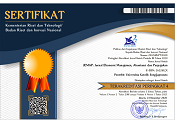Literasi Keuangan dan Keputusan untuk Berkonsultasi dengan Profesional
Abstract
Previous literatures showed that financial literacy was a determining factor for an individual's decision to consult with professionals. However, the relationship between the two may be simultaneous, so the estimation method of causality testing has been imprecise. The respondents from this study were 115 students of Masters of Management degree of Gadjah Mada University, specific on Executive Class in Jakarta. This study found that there was a simultaneous relationship between financial literacy and consultation decisions. Furthermore, causality testing was carried out using the Control Function estimation method, which contained instrumental variables in the form of family economic shocks that had been experienced in the last twenty years. This estimation method was useful to avoid endogeneity problems. The finding of this study was instrumented financial literacy significantly increased the probability of individuals to consult with professionals. Apart from the real benefits of consulting with professionals or level of professionality, a personal financial education model can be an alternative financial education that can be done by stakeholders.
Keywords
Full Text:
PDFReferences
Almenberg, Johan, and Anna Dreber. (2015). “Gender, Stock Market Participation and Financial Literacy.” Economics Letters 137: 140–42. https://doi.org/10.1016/j.econlet.2015.10.009.
Anderson, Anders, Forest Baker, and David T. Robinson. (2017). “Precautionary Savings, Retirement Planning and Misperceptions of Financial Literacy.” Journal of Financial Economics, no. 15. https://doi.org/10.1016/j.jfineco.2017.07.008.
Banks, James, Cormac O ’Dea, and Zoë Oldfield. (2010). “Cognitive Function, Numeracy and Retirement Saving Trajectories.” The Economic Journal 120 (548): F381–410. https://doi.org/10.1111/j.1468-0297.2010.02395.x.
Borodich, Sergey, Svetlana Deplazes, Nadzeya Kardash, Alexander Kovzik, and Oshkosh. (2010). “Comparative Analysis of the Levels of Financial Literacy Among Students in the U.S., Belarus, and Japan.” Journal Of Economics & Economic Education Research 11 (3): 71–86.
Bucher-Koenen, Tabea, and Annamaria Lusardi. (2011). “Financial Literacy and Retirement Planning in Germany.” Journal of Pension Economics and Finance 10 (04): 565–84. https://doi.org/10.1017/S1474747211000485.
Calcagno, Riccardo, and Chiara Monticone. (2015). “Financial Literacy and the Demand for Financial Advice.” Journal of Banking and Finance 50: 363–80. https://doi.org/10.1016/j.jbankfin.2014.03.013.
Conklin, James N.( 2017). “Financial Literacy, Broker–Borrower Interaction and Mortgage Default.” Real Estate Economics 45 (2): 376–414. https://doi.org/10.1111/1540-6229.12140.
Dunning, David. (2011). “The Dunning-Kruger Effect: On Being Ignorant of One’s Own Ignorance.” In Advances in Experimental Social Psychology, edited by James M. Olson and Mark P. Zanna, 1st ed., 44:247–96. Elsevier Inc. https://doi.org/10.1016/B978-0-12-385522-0.00005-6.
Fernandes, Daniel, John G. Lynch, and Richard G. Netemeyer. (2014). “Financial Literacy, Financial Education, and Downstream Financial Behaviors.” Management Science 60 (8): 1861–83. https://doi.org/10.1287/mnsc.2013.1849.
Fox, Michelle. (2019). “99% of Americans Don’t Use a Financial Advisor — Here’s Why.” 2019. https://www.cnbc.com/2019/11/11/99percent-of-americans-dont-use-a-financial-advisor-heres-why.html.
Hastings, Justine, and Lydia Tejeda-Ashton. (2008). “Financial Literacy, Information, and Demand Elasticity: Survey and Experimental Evidence from Mexico.” NBER Working Paper No.14538. Cambridge, MA. https://doi.org/10.3386/w14538.
Hung, Angela, Andrew M. Parker, and Joanne Yoong. (2009). “Defining and Measuring Financial Literacy.” SSRN Electronic Journal 708: 28 pp. https://doi.org/10.2139/ssrn.1498674.
Hung, Angela, and Joanne Yoong. (2010). “Asking for Help: Survey and Experimental Evidence on Financial Advice and Behavior Change.” SSRN. https://doi.org/10.2139/ssrn.1532993.
Kramer, Marc M. (2016). “Financial Literacy, Confidence and Financial Advice Seeking.” Journal of Economic Behavior and Organization 131 (January): 198–217. https://doi.org/10.1016/j.jebo.2016.08.016.
Lin, Chaonan, Yu Jen Hsiao, and Cheng Yung Yeh. (2017). “Financial Literacy, Financial Advisors, and Information Sources on Demand for Life Insurance.” Pacific Basin Finance Journal 43 (January 2016): 218–37. https://doi.org/10.1016/j.pacfin.2017.04.002.
Lusardi, Annamaria. (2003). “Planning and Saving for Retirement.” http://www.dartmouth.edu/~alusardi/Papers/Lusardi_pdf.pdf.
———. (2015). “Financial Literacy: Do People Know the ABCs of Finance?” Public Understanding of Science 24 (3): 260–71. https://doi.org/10.1177/0963662514564516.
Lusardi, Annamaria, and Olivia S. Mitchell. (2008). “Planning and Financial Literacy: How Do Women Fare?” In American Economic Review, 98:413–17. https://doi.org/10.1257/aer.98.2.413.
Lusardi, Annamaria, and Peter Tufano. (2015). “Debt Literacy, Financial Experiences, and Overindebtedness.” Journal of Pension Economics and Finance 14 (04): 332–68. https://doi.org/10.1017/S1474747215000232.
Mitchell, Olivia S., and Annamaria Lusardi. (2011). “Financial Literacy and Planning: Implications for Retirement Well-Being.” In Financial Literacy: Implications for Retirement Security and the Financial Marketplace. https://doi.org/10.1093/acprof:oso/9780199696819.003.0002.
Ooijen, Raun van, and Maarten C.J. van Rooij. (2016). “Mortgage Risks, Debt Literacy and Financial Advice.” Journal of Banking and Finance 72: 201–17. https://doi.org/10.1016/j.jbankfin.2016.05.001.
Rooij, Maarten C.J. van, Annamaria Lusardi, and Rob J.M. Alessie. (2011). “Financial Literacy and Retirement Planning in the Netherlands.” Journal of Economic Psychology 32 (4): 593–608. https://doi.org/10.1016/j.joep.2011.02.004.
Rooij, Maarten van, Annamaria Lusardi, and Rob Alessie. (2011). “Financial Literacy and Stock Market Participation.” Journal of Financial Economics 101 (2): 449–72. https://doi.org/10.1016/j.jfineco.2011.03.006.
Spataro, Luca, and Lorenzo Corsini. (2017). “Endogenous Financial Literacy, Saving, and Stock Market Participation.” Public Finance Analysis 73 (2): 135–62. https://doi.org/10.1628/001522117X14877521353555.
Stango, Victor, and Jonathan Zinman. (2017). “Published by : Wiley for the American Finance Association Exponential Growth Bias and Household Finance” 64 (6): 2807–49.
Stolper, Oscar A., and Andreas Walter. (2017). “Financial Literacy, Financial Advice, and Financial Behavior.” Journal of Business Economics 87 (5): 581–643. https://doi.org/10.1007/s11573-017-0853-9.
Sturm, Peter H. (1983). “Determinants of Saving: Theory and Evidence.” OECD Economic Studies. https://doi.org/10.1016/j.jmoneco.2005.10.016.
Woolridge, Jeffrey M. 2016. Introductory Econometrics: A Modern Approach. 6th ed. Boston, USA: Cengage Learning.
DOI: https://doi.org/10.24167/jemap.v3i1.2551
Refbacks
- There are currently no refbacks.
e-ISSN 2622-612X | View My Stats







